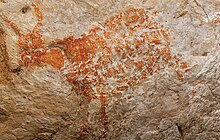Middle Stone Age
[4][5] In northern and western Africa, the wet-dry cycles of the modern Sahara desert has led to fruitful archaeological sites followed by completely barren soil and vice versa.Unlike northern Africa, shifts between lithic technologies were not nearly as pronounced, likely due to more favorable climatic conditions that would have allowed for more continuous occupation of sites.Much of the archaeological evidence for the origins of modern human behavior is traced back to sites in this region, including Blombos Cave, Howiesons Poort, Still Bay, and Pinnacle Point.[11] It is likely that the large terrestrial mammal biomass of these regions supported substantial human populations with subsistence and manufacturing patterns similar to those of ethnographically known foragers.Beginning approximately 300 kya, the large cutting tools of the Achuelian are gradually displaced by Levallois prepared core technologies, also widely used by Neanderthals during the European Middle Palaeolithic.[16] As the MSA progresses, highly varied technocomplexes become common throughout Africa and include pointed artifacts, blades, retouched flakes, end and side scrapers, grinding stones, and even bone tools.[17] Finally, during the later part of the Middle Stone Age, microlithic technologies aimed at producing replaceable components of composite hafted tools are seen from at least 70 ka at sites such as Pinnacle Point and Diepkloof Rock Shelter in South Africa.Instead, it has been argued that such technological innovations "appear, disappear and re-appear in a way that best fits a scenario in which historical contingencies and environmental rather than cognitive changes are seen as main drivers".[10] There have been a number of theories proposed regarding the development of modern human behavior, but in recent years the mosaic approach has been the most favored perspective in regards to the MSA, especially when taken in consideration with the archaeological evidence.The expansion of Homo sapiens into various ecological zones demonstrates an ability to adapt to a variety of environmental contexts including marine environments, savanna grasslands, relatively arid deserts, and forests.[41] The arrows and needle, along with hide working tools, from Sibudu Cave[21] are seen as evidence of making weapons with compound heat treated gluing technology.[42][43] Characteristically modern human behaviors, such as the making of shell beads, bone tools and arrows, and the use of ochre pigment, are evident at Panga ya Saidi in Kenya by 78,000–67,000 years ago.[44] Evidence of early stone-tipped projectile weapons (a characteristic tool of Homo sapiens), the stone tips of javelins or throwing spears, were discovered in 2013 at the Ethiopian site of Gademotta, and date to around 279,000 years ago.[45] Evidence was found in 2018, dating to about 320,000 years ago, at the Kenyan site of Olorgesailie, of the early emergence of innovations and behaviors including: long-distance trade networks (involving goods such as obsidian), the use of pigments, and the possible making of projectile points.Some of the most striking artifacts, including engraved pieces of red ochre, were manufactured at Blombos Cave in South Africa 75,000 years ago.Pierced and ochred Nassarius shell beads were also recovered from Blombos, with even earlier examples (Middle Stone Age, Aterian) from the Taforalt Caves.A family basis to foraging groups, color symbolism and the reciprocal exchange of artifacts and the formal organization of living space are, he suggests, further evidence for modernity in the MSA.Analysis shows that a liquefied pigment-rich mixture was produced and stored in the two abalone shells, and that ochre, bone, charcoal, grindstones and hammer-stones also formed a composite part of the toolkits.Evidence for the complexity of the task includes procuring and combining raw materials from various sources (implying they had a mental template of the process they would follow), possibly using pyrotechnology to facilitate fat extraction from bone, using a probable recipe to produce the compound, and the use of shell containers for mixing and storage for later use.[66] Barham[67] also views syntactic language as one aspect of behavior that in fact allowed MSA people to settle in the tropical forest environments of what is now the Democratic Republic of the Congo.Many authors have speculated that at the core of this symbolic explosion, and in tandem, was the development of syntactic language that evolved through a highly specialized social learning system[68] providing the means for semantically unbounded discourse.[70] Although the advent of anatomical physical modernity cannot confidently be linked with palaeoneurological change,[71] it does seem probable that hominid brains evolved through the same selection processes as other body parts.






MesolithicOld Stone AgeMiddle PaleolithicEarly Stone AgeStillbayHowiesons PoortLater Stone AgeAfrican prehistoryLate Stone AgehomininHomo neanderthalensisHomo sapiensGademotta FormationKapthurinKathu PanBlombos CaveStill BayPinnacle PointVan Riet Lowesub-Saharan AfricaFauresmith industryarchaic humansanatomically modern humansLevalloisGademottaMiddle AwashBouri FormationhybridizationvariabilityDiepkloof Rock ShelterKalambo FallsZambiaNeanderthalsMiddle PalaeolithicbladesUpper Palaeolithicmicrolithic technologiesArtifactHuman evolutionout of AfricaOmo Kibish FormationMumba CaveBehavioral modernityhunter-gatherersmodern human behaviorLupembanAteriansubsistenceFincha HaberaSibudu CavePanga ya SaidiOlorgesailieJebel IrhoudFlorisbadfigurative paintingsbovineLubang Jeriji Saléhsymbolic cultureSouth AfricaNassariusTaforalt CavesDiepkloofKlasiestubersLyn Wadleyhumansmodern behaviourharpoonsDemocratic Republic of the CongoartifactsHomo heidelbergensisHomo nalediHowieson's PoortfaunalKlasies River CavesBorder CaveMossel BayMumbwa CavesOut of Africa hypothesisThe Human Revolution (human origins)BibcodeAnn B. StahlBalloux, FrancoisZimmer, CarlThe New York TimesNature CommunicationsGeneral History of AfricaYong, EdThe AtlanticNatureAmos, JonathanBBC NewsWashington PostKate Robson-BrownPrehistoric technologyPrehistoryTimelineOutlineStone AgeNew Stone AgeTechnologyhistoryGlossaryFarmingNeolithic RevolutionFounder cropsNew World cropsArd / ploughDigging stickDomesticationIrrigationSecondary productsSickleTerracingBasketCookingEarth ovenGranariesGrinding slabGround stoneHearthMetateMortar and pestlePotteryQuern-stoneStorage pits